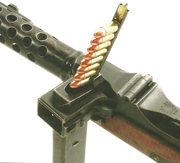The S1-100, also known under its Austrian military designation MP 34, was a Swiss-Austrian submachine gun that was produced by Steyr-Solothurn AG.
History
Development of the S1-100 began in Germany in 1924, at the firm of Rheinmetall, where Louis Stange produced a set of blueprints. Rheinmetall, however, was blocked from domestically manufacturing the gun under the terms of the Treaty of Versailles. In 1928, Rheinmetall acquired large shares in a Swiss munitions company, Waffenfabrik Solothurn AG, and a year later, Stange took the blueprints to Solothurn and oversaw the construction of the first prototype models. The chief designer on the project was Theodor Rakula. Solothurn was essentially used as a proxy under which they could develop the weapon legally outside of Germany's border. However, the company did not have the appropriate facilities in place to mass-produce the S1-100, so Solothurn entered into a merger with the Austrian firm of Waffenfabrik Steyr, which resulted in the establishment of a Zurich-based sales outlet known as Steyr-Solothurn AG.
The S1-100 began full production at Steyr's factories in 1930. The first iteration, known as the Model 1930, was produced until 1935, after which it was replaced by the slightly modified Model 1934. It was offered for export sale in a variety of different chamberings and saw some relatively limited success in South America. In 1934, the Austrian Army adopted the Model 1934 in 9×23mm Steyr and designated it the MP 34. The Austrian Police also adopted the weapon, but in the 9×25mm Mauser cartridge.
When Germany invaded Austria in 1938, the Wehrmacht and SS acquired the majority of the Austrian service S1-100s and issued them to their own troops under the designation MP 34(ö). It saw some limited use by German troops early in World War II, but was quickly phased out of service in favor of the MP 40. Most MP 34(ö)s were instead issued to the Luftwaffe and German police forces. During the Second Sino-Japanese War, the S1-100 was exported in small numbers to both the Chinese and Japanese armies, seeing minor combat use by both sides. Production of the gun ceased in 1940.
A modified version of the S1-100, known as the S17-100, was developed as a mounted support weapon, although few were made.
Design

The S1-100's unique magazine charger.
The S1-100 was a blowback-operated submachine gun that fired from an open bolt. It used a loose firing pin and the bolt's return spring was unusually located within the stock. The upper half of the receiver was hinged and could be lifted open for easy disassembly.
Like most German-designed submachine guns of the period, it fed from the left side of the receiver and incorporated a perforated barrel jacket. A bayonet could be attached to the right side of the barrel. Some later models included a magazine housing that had a upward-facing gate from which the user could insert an empty magazine vertically and then feed the rounds in using a charger. This feature was absent on the .45 ACP version of the gun.
Gallery
| |||||||||||


